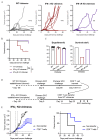IFN-γ Critically Enables the Intratumoural Infiltration of CXCR3+ CD8+ T Cells to Drive Squamous Cell Carcinoma Regression
- PMID: 33925140
- PMCID: PMC8124943
- DOI: 10.3390/cancers13092131
IFN-γ Critically Enables the Intratumoural Infiltration of CXCR3+ CD8+ T Cells to Drive Squamous Cell Carcinoma Regression
Abstract
Ultraviolet (UV) radiation-induced tumours carry a high mutational load, are highly immunogenic, and often fail to grow when transplanted into normal, syngeneic mice. The aim of this study was to investigate factors critical for the immune-mediated rejection of cutaneous squamous cell carcinoma (SCC). In our rejection model, transplanted SCC establish and grow in mice immunosuppressed with tacrolimus. When tacrolimus is withdrawn, established SCC tumours subsequently undergo immune-mediated tumour rejection. Through the depletion of individual immune subsets at the time of tacrolimus withdrawal, we established a critical role for CD8+ T cells, but not CD4+ T cells, γδ T cells, or NK cells, in driving the regression of SCC. Regression was critically dependent on IFN-γ, although IFN-γ was not directly cytotoxic to SCC cells. IFN-γ-neutralisation abrogated SCC regression, significantly reduced CD8+ T cell-infiltration into SCC, and significantly impaired the secretion of CXCL9, CXCL10 and CCL5 within the tumour microenvironment. A strong positive correlation was revealed between CXCL10 expression and CD8+ T cell abundance in tumours. Indeed, blockade of the CXCL10 receptor CXCR3 at the time of tacrolimus withdrawal prevented CD8+ T cell infiltration and the regression of SCC. Chimeric models revealed an important role for immune cells as producers of IFN-γ, but not as recipients of IFN-γ signals via the IFN-γ receptor. Together, these findings suggest a key role for IFN-γ in driving the expression of chemokines within the tumour environment essential for the destruction of established SCC by CD8+ T cells.
Keywords: CD8 T cell; IFN-γ; immune control; regression; squamous cell carcinoma.
Conflict of interest statement
The authors declare no conflict of interest. The funders had no role in study design; data collection, analysis, or interpretation; decision to publish; writing of the manuscript; or in the decision to publish the results.
Figures








References
-
- Jung J.-W., Overgaard N.H., Burke M.T., Isbel N., Frazer I.H., Simpson F., Wells J.W. Does the nature of residual immune function explain the differential risk of non-melanoma skin cancer development in immunosuppressed organ transplant recipients? Int. J. Cancer. 2015;138:281–292. doi: 10.1002/ijc.29450. - DOI - PubMed
Grants and funding
LinkOut - more resources
Full Text Sources
Other Literature Sources
Research Materials

